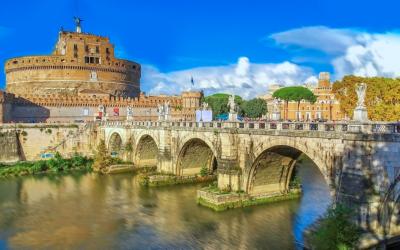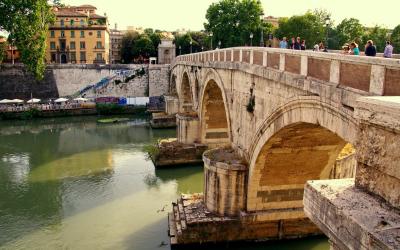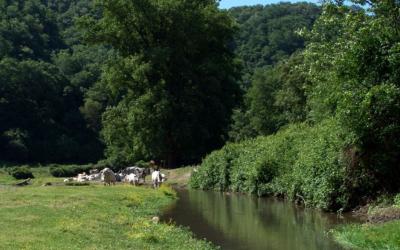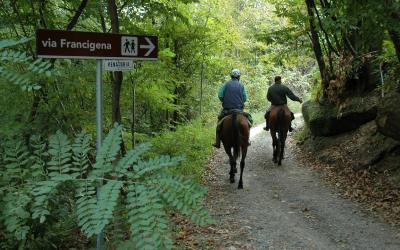But how many bridges are there in Rome? What are they called? Where are they? Legitimate questions considering that even many Romans lack this information or are often confused.
For tourists, a bridge is maybe just an excuse for a nice photo, hence so many of them are never crossed, nor are their names remembered.So let us try, following the course of the Tiber, to retrace the history of the main bridges encountered along the way, from north to south, recalling customs, anecdotes and curiosities linked to them. Shortly after arriving within the city boundaries, the first bridge we encounter is the Corso Francia Bridge, known as the “Bridge of the Eagles” or “Flaminio Bridge”, an imposing imperialist-style construction which conveys you into the Parioli quarter. Built in the 1930s as a solemn entrance to the northern part of the city, it features mighty white travertine arches overlooking the river, from which gigantic eagles look out. In the same part of the city is the Milvian Bridge, or Ponte Molle, also renamed “Padlock Bridge”, again a reference to Moccia's film. One of the oldest bridges in Rome, the site of historic battles, it is now a meeting place for the young teenagers of northern Rome, and not only, who also frequent the many clubs in the surrounding area. A little further on, opposite the Olympic Stadium, is the Duca d'Aosta Bridge: crossed daily by streams of cars, on Sundays it becomes pedestrianised and fills with the football colours of those heading to the stadium for the matches. The next bridge we come to is the Bridge of Music, dedicated to the pianist and composer Armando Trovajoli. Inaugurated in 2011, it has a contemporary design which fits in well with the nearby buildings of the Flaminio quarter, the MAXXI-Museum of 21st-Century Arts and the Parco della Musica Auditorium. For pedestrians only, it is a meeting point for sports enthusiasts, especially at weekends, and for skateboarders who can practice on the track built under the bridge, surrounded by many colourful murals. Further on is the Risorgimento Bridge, leading to Piazza Mazzini, inaugurated in 1911 and considered an example of innovation and modernity due to its reinforced concrete structure. A project envisaged by the first 'Santjust' Planning Scheme, as part of the urban reorganisation commissioned by Mayor Ernesto Nathan. Now within easy reach along the Lungotevere is the Giacomo Matteotti Bridge, which stands opposite the stele also dedicated to the first martyr of Fascism. The name was chosen at the end of the war in 1945, to replace the previous name of Littorio Bridge. Just a few steps away is the Underground Railway Bridge, as everyone has called it since it became the overground railway crossing from one side of the river to the other. It is hard to find anyone who knows that the bridge was actually dedicated to Pietro Nenni after his death in 1980. The Regina Margherita Bridge, dedicated to the Queen of Italy, connects Piazza del Popolo with Via Cola di Rienzo and is located near the area of the port of Ripetta, at that time a busy mercantile facility close to bathing establishments frequented by the Roman aristocracy. Cavour Bridge, one of Rome’s best-loved bridges and a big favourite with locals and tourists alike for the view it affords of St Peter's Basilica, is also the place from which, for many years, on the first of January, Mister OK, an old riverman, dived into the river. On the left bank stands the Ara Pacis Museum, with its display case designed by Richard Meier. The Umberto I Bridge is also known as the Piazza Navona Bridge, since it connects the Palace of Justice, in the Prati quarter, with Piazza Navona. At the same time as the construction of the bridge, the Muraglioni (Embankments) were also built to protect the city from floods. The construction of the Muraglioni, which in the urban section are 8 kilometres long, drastically altered the urban fabric and road layout of the old quarters around the Tiber, eliminating entire blocks overlooking the river and the small sandy beaches that characterised its banks. Continuing on, we come to what is Rome’s best loved, best known and most photographed bridge: the Sant'Angelo Bridge. The next bridge, the Vittorio Emanuele Bridge, in memory of King Victor Emmanuel II, connects the namesake Corso street with the Borgo quarter around the Vatican City. The Principe Amedeo Bridge is considered by everyone to be only a useful link between the old-city centre and the Aurelio quarter, without charm or particular merit. The same fate also applies to the Mazzini Bridge, which connects Trastevere with Via Giulia, with a pinch of extra interest due to its closeness to the Regina Coeli Prison. Under the bridge, on the quay of the Mazzini Bridge and up to the Sisto Bridge, the remains of William Kentridge's mural, now fading, can be seen. This was created with a particular technique in 2016 to celebrate a number of events in the history of Rome. One of the city’s most iconic bridges, the Sisto Bridge has a long history dating back to Roman times. Work carried out on the bridge over the centuries has distorted its image, time after time. The Garibaldi Bridge, built immediately after the Unification of Italy to cope with changes in urban mobility, joins the city centre to Trastevere and is dedicated to the so-called “hero of two worlds”, who fought in defence of the Roman Republic against the French on the nearby Janiculum Hill. The Pons Cestius (Cestius Bridge), in its present guise, has nothing of the ancient Roman bridge, but is still the link between the island and the right bank of the river, and leads to the Church of San Bartolomeo or, more prosaically, to the famous Trattoria di Sora Lella, which has always been a temple of Roman cuisine. Diversely, the Pons Fabricius has retained its original structure, making it today the oldest bridge in Rome, with a history of over 2000 years. This is not to say that it has not undergone various restoration and maintenance works over time, the last of which dates back to modern times on the occasion of the Jubilee of 2000. It is the city’s oldest bridge, not considering Pons Aemilius, which is better known as “Ponte Rotto” (Broken Bridge); some of its remains are still to be found in the river, close to the Island. A bridge that was damaged several times by the force of the currents around the Tiber Island bend and that today represents a big attraction, especially when adequately lit up. The Palatine Bridge is not very widely recognised and its name is unfamiliar to most. Romans call it the “English Bridge”, because of its left-hand traffic flow. Built in the late-19th century to support the increase in traffic in the city, it is mainly a vehicle crossing, although it offers a wonderful view of the Tiber Island and the Ponte rotto. Next to the bridge is a travertine arch with a very important history: it is the Cloaca Massima, one of the oldest sewage pipes built in the late-6th century at the time of the last kings of Rome. Continuing on, we come to the Sublicius Bridge, which connects the Aventine with Porta Portese. Rebuilt in the 20th century, it no longer has any element of continuity with the ancient bridge, built in the 7th century, of which it retains only the name. Similarly, the Testaccio Bridge dates back to the last century, built after World War II without any appealing parts but with the function of leading to the former Abattoir complex that now houses an important contemporary art museum and some areas of the Faculty of Architecture of the Roma Tre University. Next come two more modern bridges that lead to the Portuense and Ostiense quarters: the San Paolo Bridge, now a railway bridge, and the Industry Bridge, better known as the “Iron Bridge”. The Marconi Bridge, represents the continuation of Viale Marconi towards EUR and its construction began in 1937, to allow access to the new quarter created for the planned Universal Exhibition of 1942. The war took over, the exhibition was cancelled and the bridge was only completed after the war. Today, boats depart from the Marconi Bridge for a fascinating trip to the Ostia Antica Archaeological Park, an archaeological site of worldwide importance, protected by UNESCO. The next bridge is the Magliana Bridge, dating back to the post World War II period but already conceived and designed in the 1930s, again with the aim of connecting the new EUR quarter.
The bridge has entered the hearts of Romans, especially the younger ones, because of the film “Tre metri sopra il cielo” (Three Metres Above the Sky), much loved by teenagers and much imitated, as can be seen from the declarations of love written with spray cans.
Once a month, on the right bank of the river, near the bridge, a Sunday Antique Market is staged, much enjoyed by residents and tourists alike.
All this means that you tend to lose sight of the architectural quality of the bridge, built in the fascist era to connect the new northern neighbourhoods with the city centre, where before there were only numerous bathing establishments much frequented by Romans during the summer.
Downstream of the Matteotti Bridge, on the left bank of the river, is the “Scalo del Pinedo”, an architectural structure with two flights of steps, dedicated to the pilot De Pinedo who landed on the Tiber with his seaplane in 1925. In line with the Scalo is a platform on the river which houses the Marevivo Association, for some years now dedicated to looking after and protecting the Tiber.
The next three bridges all date from the time of the great urban development which followed the Unification of Italy, and are inevitably influenced by the “Piedmontese” style.
Its history is a long one and of great prestige, linked to the wishes of the Emperor Hadrian, who had the Mausoleum dedicated to him built on the spot on the right bank. And the bridge was precisely the link with the Mausoleum, at the time a sort of cathedral in the desert.
For a long time, therefore, the bridge was hardly ever used and it was not until the Middle Ages that its function as a crossing point for pilgrims on their way to the Vatican Basilica was recognised. The bridge's name, however, derives not from Hadrian, but from the legendary apparition of the Angel, whose statue was placed atop the castle in memory of the end of the plague in 590.
Fortunately, the restoration that took place for the Jubilee of 2000 returned the bridge to its 15th-century appearance, with the restoration of the parapets. Today it is the essential crossing for the nightlife that moves from Trastevere to Campo dei Fiori.
And now the Tiber Island appears floating, connected to the city by two bridges.
And last but not least, the Science Bridge dedicated to Rita Levi di Montalcino and inaugurated in 2013. A cycle and pedestrian bridge not sufficiently used also due to the overall delay in the redevelopment of the dismissed gasometer area and the former industrial zone of the Ostiense quarter.
Finally, the last bridge before the river mouth: the Scafa Bridge, connecting Ostia with Fiumicino.
Before the reclamation of the swamps of the Agro Romano in the late-19th century by labourers from Ravenna, the banks of the Tiber near Isola Sacra were connected by a boat called 'la scafa', hence the name of both the future bridge and the road. The current bridge was designed in the post-war period and inaugurated in 1950, but its stability has been questioned several times, even to the point of closure in recent years, with catastrophic consequences for traffic. Meanwhile, the construction of the new bridge alongside the existing one very slowly continues.




